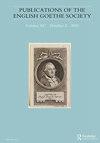歌德一生作品版本中的女神插图
IF 0.1
3区 文学
0 LITERATURE, GERMAN, DUTCH, SCANDINAVIAN
引用次数: 0
摘要
摘要插图伴随着Divan在1817年的Taschenbuch für Damen auf das Jahr第一次出版的诗歌,以及1819年完整的第一版中用阿拉伯语书写、阿拉伯式装饰和标题页的框架。我的文章调查了当代艺术家对歌德《Divan》的接受情况,他们在歌德生命的最后十年(兰贝格、艾霍尔泽和施诺尔·冯·卡罗尔斯菲尔德)为歌德作品的版本提供了封面、标题或小插曲。出版市场似乎还没有准备好对歌德提出的新的东西方传统组合进行更广泛的改编;这些版本采用了既定的具象风格,包括一些陈词滥调的东方主义。本文章由计算机程序翻译,如有差异,请以英文原文为准。
Illustrations for the Divan in Editions of Goethe’s Works during his Lifetime
ABSTRACT Illustrations accompanied the Divan from the first publication of poems in the Taschenbuch für Damen auf das Jahr 1817 and the frontispiece with writing in Arabic, arabesque ornamentation, and framing of the title page in the 1819 complete first edition. My article investigates the reception of Goethe’s Divan by contemporary artists who provided frontispieces, Titelkupfer, or vignettes for editions of Goethe’s works in the last decade of his life (Ramberg, Eichholzer, and Schnorr von Carolsfeld). It appears that the publishing market was not ready for a wider adaptation of a new West-East combination of traditions suggested by Goethe; the editions were illustrated in the established figurative style, including some clichéd orientalism.
求助全文
通过发布文献求助,成功后即可免费获取论文全文。
去求助
来源期刊

Publications of the English Goethe Society
LITERATURE, GERMAN, DUTCH, SCANDINAVIAN-
CiteScore
0.10
自引率
0.00%
发文量
15
 求助内容:
求助内容: 应助结果提醒方式:
应助结果提醒方式:


